A Gothic Revival medallion. The Campbell House Museum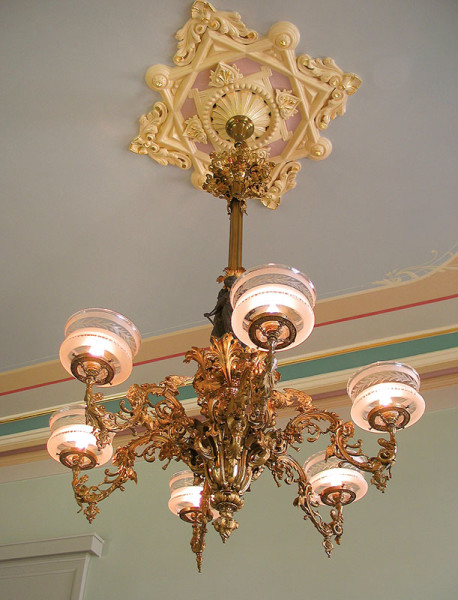
Old houses may once have had decorated ceilings, but most of those have been painted over. Standard today is flat drywall painted (what else?) ‘Ceiling White’. For a cohesive scheme, especially one grounded in history, don’t overlook the ceiling. Any treatment it’s given will stay relatively pristine in these days of smokeless heating.
Throughout decorating history, even residential ceilings were embellished with color, striping, cast-plaster ornaments, corner fans, borders, specialty papers, and murals. Stencils appeared early on, but the late 19th-century Victorian era was the heyday of the embellished ceiling. Faced with ceiling heights of 9′ or more on the main floor, decorators always considered the ceiling along with the walls. At its simplest, the ceiling may have been painted white tinted with a bit of the wall color, with a stripe around the perimeter, and maybe tiny corner fans. In general, the higher the ceiling, the more elaborate the decoration. Full embellishment would include a border or two, corner treatments, a center rosette, and a field—done in paper, freehand painting, stenciled decoration, or a combination of those.
An example of a beautiful, decorative metal ceiling. Brian Vanden Brink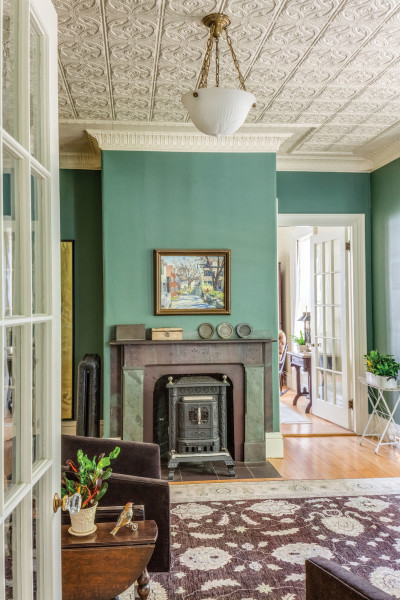
The ceiling was still important between 1901 and 1945. Public rooms, particularly in Arts & Crafts and English Tudor houses, often had beams—stenciled or with chamfers picked out in color. The spaces between beams might be treated with soft color, a burlap paper, or a border stencil. In other fine rooms, the ceiling treatment played off the frieze, picking up its colors or repeating a motif. Complementary ceiling fill papers were light in tone and favored “natural” hues, such as limestone and sand colors accented with eggplant, earthy amber, and a soft olive green.
Beadboard
The Painting Room sports refurbished beadboard wainscoting; this section of the room highlights Winslow Homer’s career as an illustrator. Trent Bell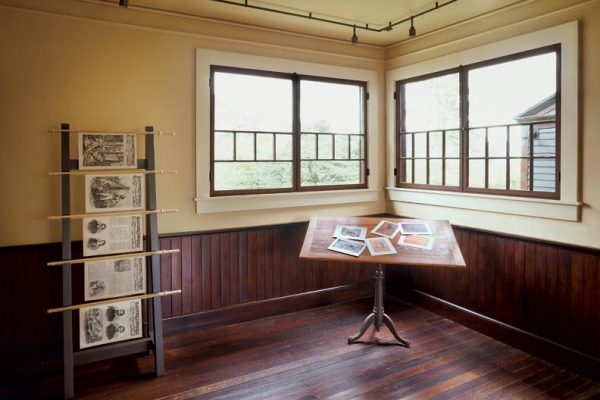
Common by the turn of the 20th century, beadboard started out as an inexpensive and easily installed finish for informal rooms like kitchens, for porch ceilings, stables, and train stations. Beadboard (aka tongue-and-groove or car siding) was made from scraps of lumber milled with a thin ridge or tongue on one edge and a corresponding groove on the opposite. Depending on the wood species (commonly pine or fir), you may choose to stain and seal, or prime and paint your ceiling, or finish it with orange shellac—
a wonderful look on fir.
After the First World War, European-influenced Romantic Revival house styles were built in the growing suburbs. Many walls and the occasional ceiling were troweled with rough or textured plaster, to give an impression of age. Ceilings were not universally monochromatic in this period (as they were in Colonial Revival homes before and after). In fact, there was a revival of ceiling decoration for Spanish Revival and Beaux Arts homes. Wood coffers, colored stains, painted decoration, and stenciling on or between beams were all popular treatments. Tudor Revival houses had ceilings with heavy beams,
or with “Jacobean” plaster featuring intricate strapwork.
Ornate Details
Now shape took precedence over decoration. There was a vogue for coved ceilings for houses in neoclassical, Tudor, and Spanish styles. A concave arc of plaster formed a transition between the wall and the ceiling plane, with no right angle. Decoratively, the cove might be treated as part of the ceiling or as part of the walls—each gave a different effect and altered the perceived height of the room. The cove might be ornamented with applied plaster in a “wedding cake” manner, often with swags. A coffered ceiling, also popular in Tudor and Mediterranean Revival houses, is one divided into a grid of recessed square or octagonal panels; it’s also called a lacunar ceiling.
Modernism took hold after the Depression; gone were cornices and mouldings, as plaster met plaster at an unembellished right angle. White ceilings, like the ones we grew up with, became the norm.
A decorative plaster ceiling. Courtesy JP Weaver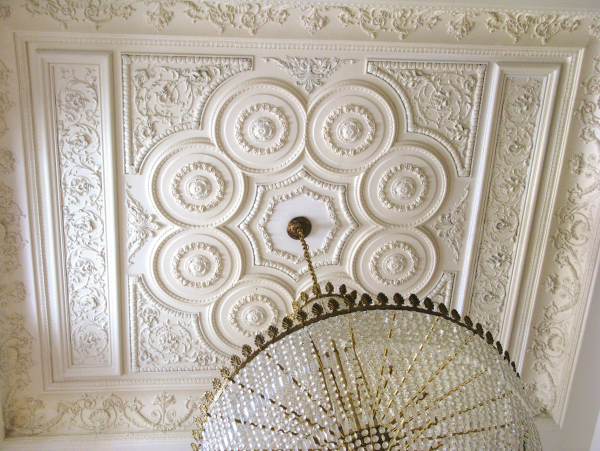
The Language of Ceiling Talk
Border A band of ornament; in the domestic interior, usually 9″ or less.
Box Beam A “faux” decorative beam built up from boards joined together to form a shell, as opposed to a solid structural beam. Electrical lines were sometimes run in the boxes for beam lights. Multiple intersecting beams create a coffered effect.
Cornice The moulding, usually made of plaster or wood, at the top of the wall just below the ceiling.
Chamfer On a ceiling beam, an edge that has been beveled or angled off, usually at 45 degrees, lending a more finished look.
Coffer A sunken panel; a coffered ceiling is one with a grid of sunken and raised areas, whether in plaster, stone, or wood. Once offering structure with reduced weight, it is now generally a decorative device.
Corner Fan Ornamental design, usually in the form of a quarter circle, bridging the right angles of an intersection or corner.
Cove A concave moulding or curved surface (as in plaster) forming a junction between walls and ceiling.
Crown Decoration An encircling band of ornament that unites wall and ceiling as one decorative whole. Usually includes the picture rail, frieze, cornice, and enrichment bands.
A re-creation of a parlor ceiling. William Wright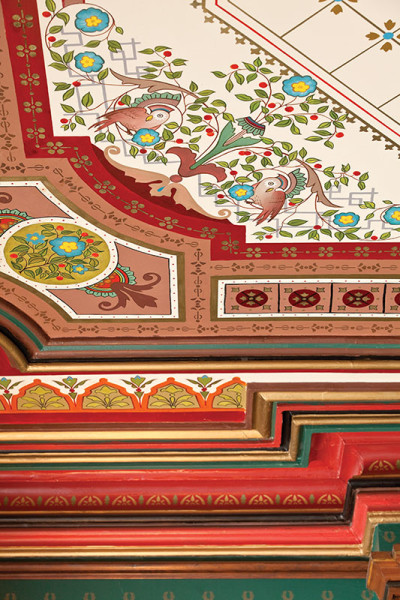
Enrichment A pattern, often a small geometric, richer in coloring than normally used on a full wall. May be used as a dado, in wall panels, in the cove, or as filling in ceiling designs.
Fill(ing) The main portion of a wall between the dado and frieze. Also, any ceiling portion within borders.
Frieze A decorative horizontal band along the upper part of a wall, or the design intended for that space.
Medallion Circular, oval, or square relief embellishment, most often in plaster, at the center of the ceiling, often surrounding the canopy of a hanging light fixture. When round and petal-like, also called a rosette.
Metal Ceilings Now prized on their own merit, so-called tin ceilings once stood in for more expensive plasterwork, and eventually got a bad name as a cover-up for failing plaster. But they came back big-time during the 1980s Victorian Revival and remain a versatile, affordable decorating option. Designs range from pebble texture and grids to diaper patterns, opulent Victorian cartouches, and Arts Deco geometrics. The metal panels (tin-plated steel, galvanized steel, or brass or copper) are stamped in an embossing machine; they attach to plywood sheathing or wood furring strips. Components include not just the field pattern, but also filler strips and cornice mouldings. The ceiling may be painted to look like plaster or polychromed (don’t go overboard: there’s already a lot of pattern); brass or copper may be clear-coated for an industrial look. Today the classic patterns are also made in vinyl tiles; because these can be glued or stapled to an existing ceiling, they’re good for low-ceilinged rooms or basements.
Plaster Ornament Plaster ceiling medallions could be found in parlors plain and opulent from the late 18th century and through the Victorian era. (By the 1930s, they were very much out of favor.) Medallions changed style along with houses, featuring Greek anthemions in the 1830s, Gothic trefoils in the 1850s, sunflowers in the 1880s. Fretwork, acanthus leaves, and rosettes were perennial favorites. The medallion was sized according to the breadth and height of the room. It would be painted to complement a polychromed room. It often disguised a chandelier hook, a gas line or electrical box, sometimes even an air duct. Although lighter-weight molded plastic medallions are available today (some quite nice, others not so), you can still buy real cast-plaster medallions in many styles.
Cole & Son’s ‘Cloud Ceiling’ paper. Blackstone Edge Studios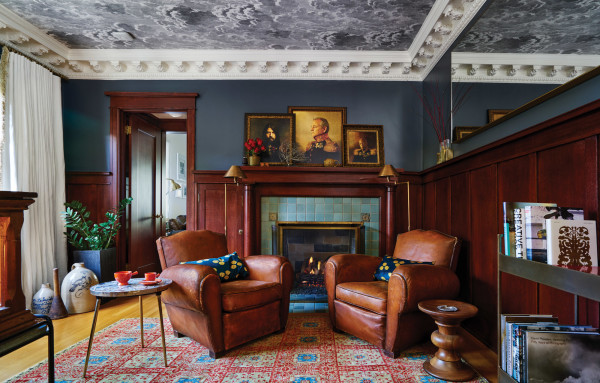
Picture Rail A moulding (often 18″ below the cornice) from which framed pictures could be suspended without damaging the wall surface. The area above the rail might be treated as part of the wall or part of the ceiling in its decoration.
Polychrome To decorate in many or various colors, from the Greek words for multiple and color.
Stencil Repeating ornament applied in paint through a design cut out of a template. Multi-color designs require multiple stencils (templates).
The Use of Borders
Using borders in ceiling design either can play up or disguise room irregularities or asymmetry. The most common Victorian-era ceiling layout has the border run so as to avoid, say, the chimneybreast, and instead create a regular geometry. The space between the border and cornice might be filled with paint or pinstripes, a wallpaper enrichment, or a stencil. The resulting center panel may be (typically) rectangular, or square or even polygonal. The center is treated in paint, paper, or stenciling. A ceiling in a very large, formal room may be subdivided into geometric sections.
A second approach seeks not to minimize irregularity, but instead to call attention to features by running borders that faithfully follow all the turns of the walls, resulting in an irregular central space in the room. Companies selling Victorian Revival wallpaper will help you with your design.
‘Adena Pin Ring’ bordered with ‘Rose and Sprig’ Adelphi wallpaper Eric Roth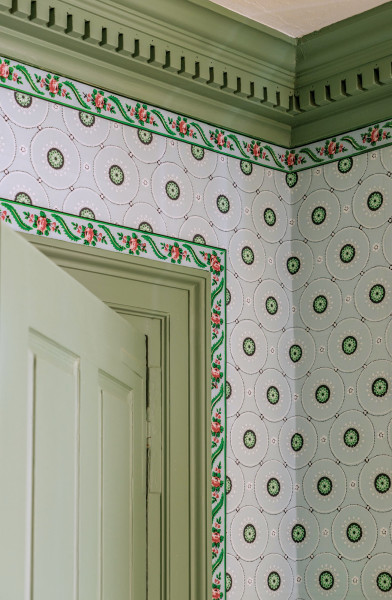
How Much Paper?
Most wallpaper single rolls cover about 30 square feet. So here’s how to calculate the number of rolls you need: Multiple the width (in feet) of the ceiling, or of the center portion if you’re using multiple papers, by its length, and divide the sum by 30. Always round up. If you have a lot of irregularities—chimneybreast, window bays—add 10–15 percent to allow for waste. Borders are measured and sold by the linear foot.
Does It Peel No Matter What?
Then calcimine (kalsomine, distemper) probably remains—this early finish was meant to be washed off before it was reapplied. Calcimine on plaster causes subsequent oil or latex paints to fail. The only answer is to hand-scrape off all the paint (taking precautions against lead), then scrub with a sudsy solution of water and detergent (Spic’n’Span, TSP, or strong dishwashing liquid). Scrub and squeegee, then rinse with clean water. As it dries, rub it with a dark cloth. If you see any “chalk,” keep scrubbing. Prime with an oil or alkyd primer.







